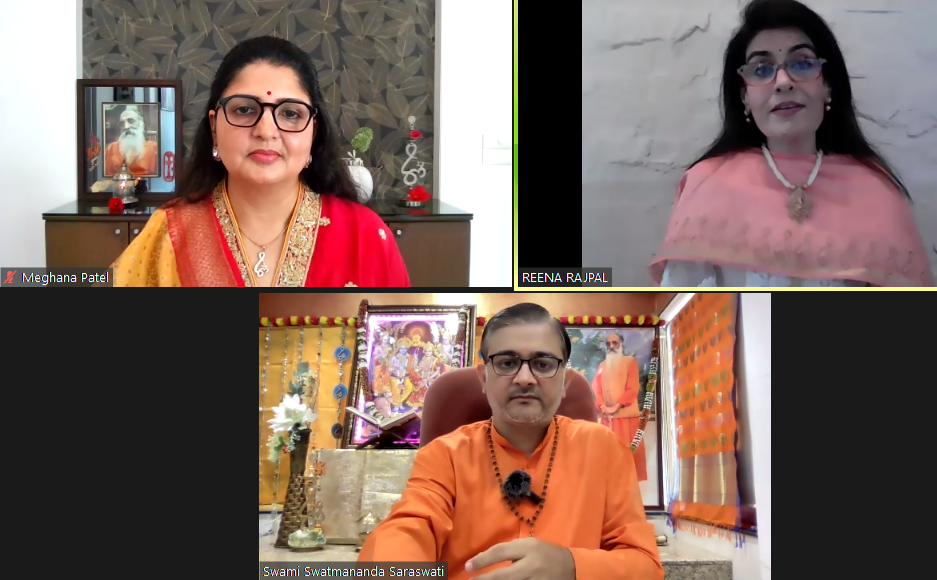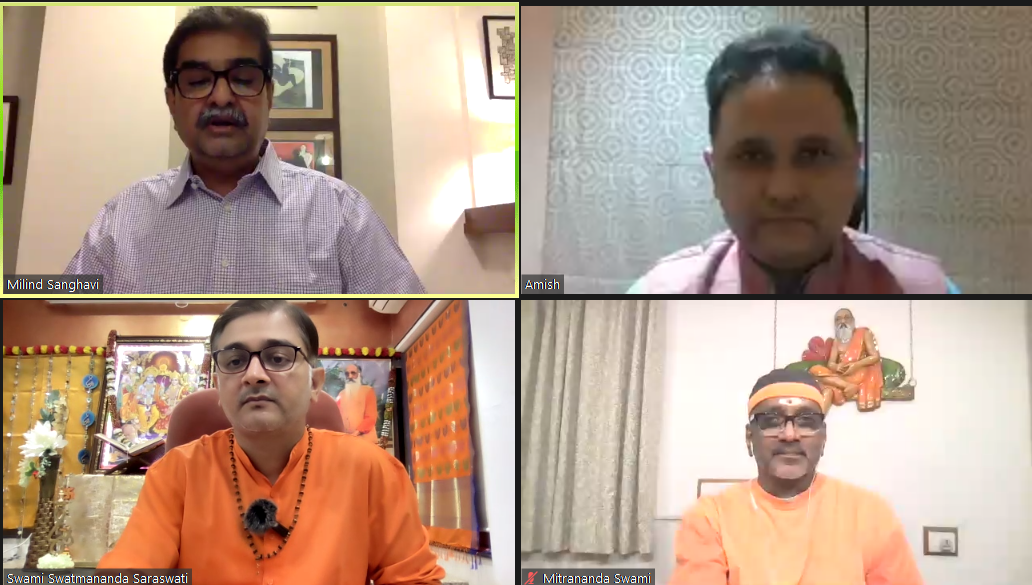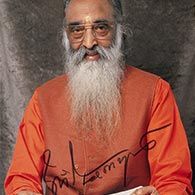DAY 1 - 13th April
Session 1
Sri Ram - An Ideal Hindu
Swami Swatmananda

Sri Ram is Brahman of Veda-s, who took human avataar to re- establish Dharma. In this avatar, he is the role model for every Hindu or follower of Sanatana Dharma. What made him an ideal Hindu was the fact that he chose to follow and practice core Hindu beliefs. Some are listed below.
* Veda-s are the foundation of Sanatana Dharma. They are Anaadhi (beginning-less), Ananta (endless) and Apaurusheya (revelations). Rama diligently studied Veda-s and engaged in the well-being of all.
* Avataarvad, Reincarnation is a core Hindu belief that the Supreme which is unmanifest, will manifest by its own will, without any binding and in the awareness of its Divinity. This is in order to re-establish Dharma, restore faith and rescue those who are suffering. Sri Rama is the seventh avataar of Dasha Avataar-s.
* Shodasha Upachaara – the 16 Rites: Garbhadhaana (purifying the unborn child), Pumsavana (ensure good health of foetus), Simantayana (to protect and stimulate the foetus’ intellect), Jaatakarma (preparing of birth chart), Naamakarana, Nishkramana, Annapraashna, Karnabhedha, Chudakarana, Vidyaarambha, Upanayana, Samavartana, Vivaaha, Pancha Maha Yagna, Vanaprastha and Antyeshti Samskaara. Performing these samskaaras helps us to develop our subtle intellect and a pure mind. Except for the first three and the last one, Sri Rama diligently performed these samskaras.
* Necessity of a Guru – Brahma Vidya can never be grasped without a Guru. Sri Rama studied under Vashishta rishi, Vamadeva, Vishvamitra rishi and later, Bharadwaja muni and Agastya rishi. Bhagawan Rama did seva of all his gurus, as well as obeyed all their wishes implicitly.
* Sadhana - Bhagawan undertook many sadhanas like chanting Aditya Hrdayam, Gayatri Mantra and performing Sandhyavandanam, every single day. Sadhanas keep us grounded and grateful.
* Upaasana - Hindus have the freedom of choice about doing Upasana, of Saguna Saakaar, Sagun Niraakaar or Nirguna Niraakaar forms of worship. Sri Ram worshipped Shiva and built a Shivalinga at Rameshwaram.
* Monotheism - Hindu belief is that there is one Supreme Consciousness, that takes many forms. We are manifestations of that Divinity.
* Anchoring in Values - This manifests through Righteousness and makes us live a life of compassion and harmony. Valmiki asks Narada to name an individual at that time, who was virtuous, strong, brave, righteous, grateful, truthful, firm in his resolve, well educated, capable, knower of the Self, resplendent, who had conquered anger and was compassionate to all. Narada said, “It is Sri Rama.”
* Love - This quality is the source of doing our duty and the spiritual knowledge of Oneness. Sri Rama loved all, from the lowly squirrel to the tribal Guha, equally, without discrimination.
* Family Unit – This is an important Hindu way of life, which helps us identify with others and lose our ego.
* Law of Karma – It is a Hindu belief that what we are going through is the result of what we have done in the past (prarabhdha). We must accept it. But in the present, we have free will in how to respond (purushaartha) and change the course.
* Life after Death, Maranaantara Gati and Punar Janma (reincarnation) - The jiva proceeds after having dropped the body, until it can find another appropriate body to exhaust karmas. This teaches us to live righteously.
* Varna Vyavastha - Brahmana, Kshatriya, Vaishya and Shudra - Four categories where professions are chosen by ability and temperament. When one lives in one’s svadharma, there is harmony, as there was in Ayodhya and in Ram Rajya.
* Essential Divinity - Everything is essentially Divine. This enables us to feel Oneness with the universe. Sri Ram believed, lived and acted in sync with all these beliefs and made them living truths, for us to emulate. So let us uncompromisingly, with our vichaara, aachaara and vyavahaara be true Hindus, both within and without and say - I am proud to be a Hindu.
Report by
Chandni Hitkari
Chinmaya Sagar Zone
--------------------------------------------------------------------------------------------------------
DAY 1 - 13th April
Session 2
Are Siya Ram relevant today?
by Sri Amish Tripathi & Dr. Sapna Sharma

Sri Amish Tripathi is the popular author of Shiva Trilogy, Ram Chandra series and other books. Dr. Sapna Sharma is a motivational speaker, spiritual counsellor and author. Amishji opened the topic with a startling fact that the re-telecast of Ramayana in Doordarshan had a viewership in India of more than the global viewership of Game of Thrones, the biggest TV series ever on OTT platform! The life of Sri Ram and Sita becomes more relevant in today’s pandemic because they always followed the rules, always looked at the larger picture. He also appealed to all Indians that on the occasion of building of Ayodhya temple, we should explore what we can learn from the life of Sri Ram and Sita.
When questioned why today’s youth finds Ravana more meritorious and find it impractical to live like Rama, he said that Rama advised Lakshmana to learn from Ravana. He asked to be respectful to Ravana, since he was a knowledgeable person and a Shiva bhakta. However, he had no control on his desires and a big ego. The key difference between the life of Rama and Ravana is the response to the grief suffered. Sri Rama was always noble, while Ravana only became angrier.
When questioned about seemingly contradictory decisions of Rama, like killing of Vali from behind a tree, Amishji pointed out that when properly understood, the reasons are dharmic. How do we see the right aspect? He replied that Ramayana is the journey of Rama to Rama. He is remembered for Ram Rajya, so any decision from his life can be viewed in that light. Amishji also threw light on his own journey, from atheist to believer and appreciated the concept of idol worship in our culture. Rama was a Maryada Purshottam - an ideal follower of laws.
Dr. Sapna Sharma echoed Amishji’s advice of focusing on the lessons to learn from Ramayana. She mentioned that Sita had choices, when she took various decisions in life and had to face consequences. There is a bit of Rama, Sita and Ravana in us. We choose to develop which aspect we want. Swami Mitrananda and Swami Swatmananda reiterated the need to go back to original texts and understand the perspective of the masters – the depth in narrations that come from purity, clarity and surrender.
Report by
Anamika Chakravarty
Chinmaya Mahima Zone


